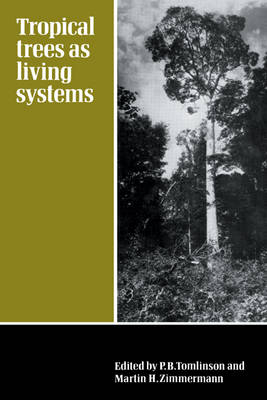
Tropical Trees as Living Systems
Cambridge University Press (Verlag)
978-0-521-14247-2 (ISBN)
When this book was first published in 1978, tropical forests were unquestionably the largest scientifically unexplored region of the world, and being rapidly depleted by short-term exploitation. Species were being rendered extinct at a rate that is probably greater than the rate at which they are being discovered. This book is an assessment of scientific knowledge of tropical tree biology - construction, development, physiology, reproductive biology and evolution - set against a background of community ecology and forest structure. Its emphasis is on the study of the individual tree as a living system integrated into the larger forest community. The book publishes the results of the Fourth Cabot Symposium held at the Harvard Forest in 1976 and presents the special knowledge of the participants, each an expert in a special field. Much of the subject matter is presented in the form of reviews, making information easily accessible to an interested nonspecialist audience.
List of contributors; List of chairmen of sessions and discussions; Foreword Lawrence Bogorad; Editorial preface; Part I. Origins and Variations: 1. Fossil evidence on the evolutionary origin of tropical trees and forests James A. Doyle; 2. Geographic variations in tropical tree species Trevor Whiffin; Part II. Reproduction and Demography: 3. Chemical aspects of the pollination biology of woody plants in the tropics Herbert G. Baker; 4. Seeding patterns of tropical trees Daniel H. Janzen; 5. Strategies of establishment in Malayan forest trees F. S. P. Ng; 6. Studies on the demography of tropical trees José Sarukhán; Part III. Architecture and Construction: 7. Branching and axis differentiation in tropical trees P. B. Tomlinson; 8. Architectural variation at the specific level in tropical trees Francis Hallé; 9. Modular construction and its distribution in tropical woody plants Marie-Françoise Prévost; 10. Architecture of the New Caledonian species of Araucaria Jean-Marie Veillon; 11. Growth forms of rain forest palms John Dransfield; 12. Araliaceae: growth forms and shoot morphology W. R. Philipson; 13. A quantitative study of Terminalia branching Jack B. Fisher; Part IV. Roots, Leaves, and Abscission: 14. Roots and root systems in tropical trees: morphologic and ecologic aspects Jan Jenik; 15. On the adaptive significance of compound leaves, with particular reference to tropical trees Thomas J. Givnish; 16. Abscission strategies in the behavior of tropical trees Fredrick T. Addicott; Part V. Organizational Control: 17. Formation of the trunk in woody plants P. Champagnat; 18. Multiple growth correlations in phanerogams R. Nozeran; 19. Relation of climate to growth periodicity in tropical trees Paulo de T. Alvim and Ronald Alvim; 20. Control of shoot extension and dormancy: external and internal factors K. A. Longman; 21. Feedback control and age-related changes of shoot growth in seasonal and nonseasonal climates Rolf Borchert; 22. Structural requirements for optimal water conduction in tree stems Martin H. Zimmmermann; Part VI. Community Interactions: 23. Architecture and energy exchange of dicotyledonous trees in the forest Roelof A. A. Oldeman; 24. Community architecture and organic matter dynamics in tropical lowland rain forests of Southeast Asia with special reference to Pasoh Forest, West Malaysia Tatuo Kira; 25. Crown characteristics of tropical trees P. S. Ashton; 26. Tree falls and tropical forest dynamics Gary S. Hartshorn; 27. Gaps in the forest canopy T. C. Whitmore; Index to subjects and plant genera.
| Erscheint lt. Verlag | 10.6.2010 |
|---|---|
| Verlagsort | Cambridge |
| Sprache | englisch |
| Maße | 152 x 229 mm |
| Gewicht | 1000 g |
| Themenwelt | Naturwissenschaften ► Biologie ► Botanik |
| ISBN-10 | 0-521-14247-4 / 0521142474 |
| ISBN-13 | 978-0-521-14247-2 / 9780521142472 |
| Zustand | Neuware |
| Haben Sie eine Frage zum Produkt? |
aus dem Bereich


